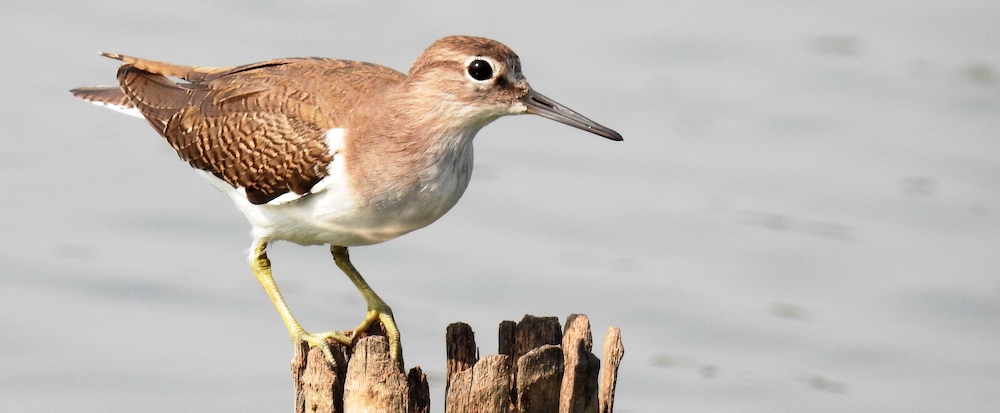61 Boring Birds: #23 Common Sandpiper

Lockdown is slowly lifting, but I haven’t changed my behaviour very much at all. Still solitary walks and cycles, and infrequent visits to the supermarket and food shops. Using public transport to get to the real countryside — a hike on the south downs maybe — is tempting, but I have resisted the urge so far.
One opportunity to alter my routines I haven’t yet taken up is the earlier opening hours of the wetlands. Open to the public from 10.30 each day, the same restriction also applied to permit holders until recently, but now the gates are open from 7am if you’re name’s on the list. (The cafe is also opening up again. The toilets can’t be far behind.)
But I haven’t been taking advantage of the undisturbed early hours. Partly laziness, but also genuinely being quite enamoured with roaming about at close of day.
This morning was not a prime candidate to break the habit. A middling, and worsening, hangover from an enjoyable online drink and political chinwag with Matt meant my alarm was the recipient of more early morning abuse than usual. However, alongside the snooze ticker counting back down to impending rude re-awakenings were a few messages from the whatsapp birders group — somebody had found an unidentified wader.
Ask any birdwatcher what their favourite family of birds is and they will all tell you something completely different (of course they will — we’re not automata!). But I’d hazard a bet that a poll of popularity using the single transferable vote system would see waders — though not front-runners at first — slowly rise to take the top spot. Everybody’s favourite runner-up.
They are familiar but exotic, beautiful but drab and gawky, approachable and spectacular. All variants on the basic theme of long legs, necks and beaks, and life stories that take them on epic journeys from wetland gregariousness in the winter to romantic, wind-swept isolation to breed. Not one wader in the bird book can you point to and say, “That’s the dull one”.
I can remember waiting for the school bus as a child watching flocks of lapwing flickering over “The field” (a landmark in every semi-rural neighbourhood). In late summer, cycling in the hills above Bwlchgwyn we’d sometimes find fields full of curlew, probing the soil and calling winsomeley to each other. Both rare sites nowadays. The curlew, in particular, they fear is well on its way to extinction.
A third memory which is burnt into my brain is walking along the water’s edge at Llanddona in Anglesey with a group of twenty-odd tiny waders running at my feet. In bird books the smaller waders look big by dint of the fact their layout is that of a big bird - long legs, necks and beaks — this is clearly something like a heron in size. But in fact, many are as small as sparrows. At the time, I identified them as little stints — the smallest found in Britain — beacause they were so tiny, but in hindsight their behaviour, scampering after retreating wavelets to pick up tiny invertebrates, screams “sanderling”, which are a gargantuan 20cm long.
And I have never seen one of these teeny toy birds at Walthamstow. In any given month a handful of waders will be seen, resting before resuming their long-haul voyages to or from the breeding grounds. But the ones I’ve generally seen have been among the larger ones, so somebody reporting the sight of a possible “calidris” wader (the scientific name for these smaller types) meant an almost certain “patch tick”. Do not be fooled by this meandering, whimsical blog — when the chips are down, birdwatching is all about expanding the all consuming list.
But it was not to be. After a frantic cycle over to No. 5 reservoir, meeting Chris at the far corner and then accidentally — to my shame — frightening the bird, it revealed itself to be a Common Sandpipers. These are still delightful little waders, and I remember fondly the first time I came across one, standing sentinel next to a miniature pool on the island of Skomer. On the Isle of Skye last year I enjoyed sitting among them as they noisily declared possession of a stretch of river at the base of the Black Cuillin. In spring and autumn up to about fifteen may pass through Walthamstow, gathering in little pods and escaping over the water with flickering wingbeats and a panicked piping call when humans approach. Last winter one overwintered, eking out an existance in this largely frostless year.
But context is everything and today, hungover, tired and hopeful of increasing my patch tally, I couldn’t help but be deflated by the sight of this unseasonal visit by a characterful bird.
But this is a blog not just about birds, but about birdwatching. So, despite seeing an even more unusual (for the season) green sandpiper later in the day, and having much to say about the blinding whiteness of its rump feathers and its speech-like complaining call as it flew away (I clumsily flushed this bird too), I’ll make it up to the common sandpiper by giving it today’s page. If it didn’t delight me, then I can only shrug my shoulders and express regret. But it did, however, achieve something far rarer — it revealed me.
🦅 First boring bird
Related boring birds: Green sandpiper
🦚 All boring birds
Yaffle